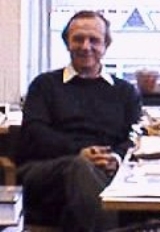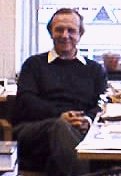
John E. Baldwin
Encyclopedia

Royal Society
The Royal Society of London for Improving Natural Knowledge, known simply as the Royal Society, is a learned society for science, and is possibly the oldest such society in existence. Founded in November 1660, it was granted a Royal Charter by King Charles II as the "Royal Society of London"...
(-) has worked at the Cavendish Astrophysics Group
Cavendish Astrophysics Group
The Cavendish Astrophysics Group is based at the Cavendish Laboratory at the University of Cambridge. The group operates all of the telescopes at the Mullard Radio Astronomy Observatory except for the 32m MERLIN telescope, which is operated by Jodrell Bank.The group is the second largest of three...
(formerly Mullard Radio Astronomy Observatory) since 1954. He played a pivotal role in the development of interferometry
Astronomical interferometer
An astronomical interferometer is an array of telescopes or mirror segments acting together to probe structures with higher resolution by means of interferometry....
in Radio Astronomy
Radio astronomy
Radio astronomy is a subfield of astronomy that studies celestial objects at radio frequencies. The initial detection of radio waves from an astronomical object was made in the 1930s, when Karl Jansky observed radiation coming from the Milky Way. Subsequent observations have identified a number of...
, and later astronomical optical interferometry
Optical interferometry
Optical interferometry combines two or more light waves in an opticalinstrument in such a way that interference occurs between them.Early interferometers used white light sources and also monochromatic light from atomic sources...
and lucky imaging
Lucky imaging
Lucky imaging is one form of speckle imaging used for astronomical photography. Speckle imaging techniques use a high-speed camera with exposure times short enough so that the changes in the Earth's atmosphere during the exposure are minimal.With lucky imaging, those optimum exposures least...
. He made the first maps of the radio emission from the Andromeda Galaxy
Andromeda Galaxy
The Andromeda Galaxy is a spiral galaxy approximately 2.5 million light-years from Earth in the constellation Andromeda. It is also known as Messier 31, M31, or NGC 224, and is often referred to as the Great Andromeda Nebula in older texts. Andromeda is the nearest spiral galaxy to the...
and the Perseus Cluster
Perseus Cluster
The Perseus Cluster is a cluster of galaxies in the constellation Perseus. It has a recession speed of 5,366 km/s and a diameter of 863′...
, and measured the properties of many active galaxies. In 1985 he performed the first Aperture Masking Interferometry
Aperture masking interferometry
Aperture Masking Interferometry is a form of speckle interferometry, allowing diffraction limited imaging from ground-based telescopes. This technique allows ground based telescopes to reach the maximum possible resolution, allowing ground-based telescopes with large diameters to produce far...
observations, and then led the construction and operation of the Cambridge Optical Aperture Synthesis Telescope
Cambridge Optical Aperture Synthesis Telescope
COAST, the Cambridge Optical Aperture Synthesis Telescope, is a multi-element optical astronomical interferometer with baselines of up to 100 metres, which uses aperture synthesis to observe stars with angular resolution as high as one thousandth of one arcsecond COAST, the Cambridge Optical...
, and helped develop the lucky imaging
Lucky imaging
Lucky imaging is one form of speckle imaging used for astronomical photography. Speckle imaging techniques use a high-speed camera with exposure times short enough so that the changes in the Earth's atmosphere during the exposure are minimal.With lucky imaging, those optimum exposures least...
method. In 2001 he was awarded the Jackson-Gwilt Medal
Jackson-Gwilt Medal
The Jackson-Gwilt Medal of the Royal Astronomical Society has been awarded regularly since 1897 for the invention, improvement, or development of astronomical instrumentation or techniques; for achievement in observational astronomy; or for achievement in research into the history of astronomy.The...
for his technical contributions to the fields of interferometry
Interferometry
Interferometry refers to a family of techniques in which electromagnetic waves are superimposed in order to extract information about the waves. An instrument used to interfere waves is called an interferometer. Interferometry is an important investigative technique in the fields of astronomy,...
and aperture synthesis
Aperture synthesis
Aperture synthesis or synthesis imaging is a type of interferometry that mixes signals from a collection of telescopes to produce images having the same angular resolution as an instrument the size of the entire collection...
.
He matriculated as a member of Queens' College, Cambridge
Queens' College, Cambridge
Queens' College is a constituent college of the University of Cambridge, England.The college was founded in 1448 by Margaret of Anjou , and refounded in 1465 by Elizabeth Woodville...
in 1949 and has been a Life Fellow of the College since 1999.

